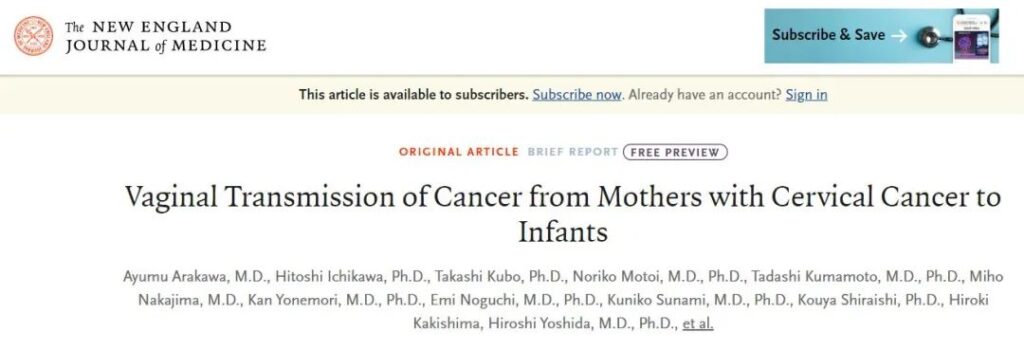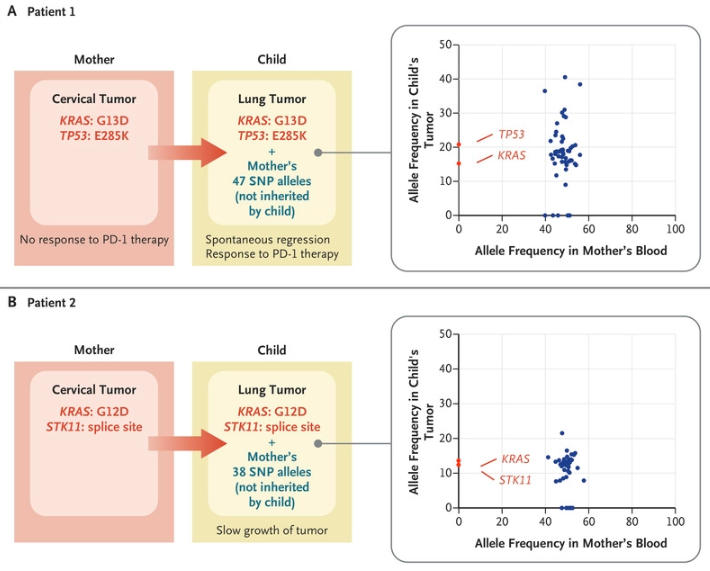NEJM: mother-to-child transmission of cancer.
- Normal Liver Cells Found to Promote Cancer Metastasis to the Liver
- Nearly 80% Complete Remission: Breakthrough in ADC Anti-Tumor Treatment
- Vaccination Against Common Diseases May Prevent Dementia!
- New Alzheimer’s Disease (AD) Diagnosis and Staging Criteria
- Breakthrough in Alzheimer’s Disease: New Nasal Spray Halts Cognitive Decline by Targeting Toxic Protein
- Can the Tap Water at the Paris Olympics be Drunk Directly?
NEJM: mother-to-child transmission of cancer
NEJM: mother-to-child transmission of cancer.. NEJM: mother-to-child transmission of cancer. Cancer mothers give birth to infants with cancer. After treatment, both children have not relapsed.
The transmission of cancer from a mother to her offspring is a very rare event, occurring in only 1 baby in every 500,000 cancerous mothers. In contrast, approximately 1 in 1,000 live births involves a mother with cancer.
Recently, however, the New England Journal of Medicine (NEJM) reported two cases of mother-to-child transmission of cancer. Both of these children have lung cancer, and their mother has cervical cancer. These children are believed to have inhaled tumor cells during the normal delivery.

In one case, the mother was diagnosed with squamous cell carcinoma of the cervix 3 months postpartum, and subsequently developed lung metastases with neuroendocrine tissue. After the child had a cough that lasted for two weeks at 23 months, his family took him to the hospital and found that he had cancer in both lungs and was eventually diagnosed as neuroendocrine cancer.
In another case, the mother found a polypoid tumor of the cervix during pregnancy, and an adenocarcinoma was found on a biopsy after delivery. When the child was 6 years old, he went to the local hospital with chest pain on his left side. A CT scan revealed a 6 cm mass in his left lung, which was eventually diagnosed as mucinous adenocarcinoma of the lung. His mother died of cervical cancer two years after she was born.
After treatment, both children have not relapsed.
The researchers performed next-generation sequencing of the tumor and found that the tumor cells of the two pairs of mother and child had the same genetic mutation. Dr. Ayumu Arakawa, a pediatric oncologist and lead researcher at the Tokyo National Cancer Center Hospital, said: “In our case, we believe that the tumor originated from the mother’s vaginal transmission of the baby through inhalation of vaginal fluid contaminated by the tumor at birth.”

The researchers said that the small number of previously observed cases usually involved cancer cells crossing the placenta and entering the developing fetus. Leukemia, lymphoma and melanoma are the most common cancers in children that are transmitted through the placenta. The two newborns seem to be the first reports of lung cancer infection by inhaling cancer cells from cervical tumors.
Debbie Saslow, senior director of HPV-related and female cancers of the American Cancer Society, said that this possibility was never expected before, so this case is very attractive. Most cervical cancers are caused by human papillomavirus (HPV). There is an effective vaccine, and as more people get HPV vaccine, such cases will become increasingly rare.
Very rare! Mother-to-child transmission of cancer
Very rare! Mother-to-child transmission of cancer: NEJM: mother-to-child transmission of cancer. Cancer mothers give birth to infants with cancer. After treatment, both children have not relapsed.
The transmission of cancer from a mother to her offspring is a very rare event, occurring in only 1 baby in every 500,000 cancerous mothers. In contrast, approximately 1 in 1,000 live births involves a mother with cancer.
Recently, however, the New England Journal of Medicine (NEJM) reported two cases of mother-to-child transmission of cancer. Both of these children have lung cancer, and their mother has cervical cancer. These children are believed to have inhaled tumor cells during the normal delivery.

In one case, the mother was diagnosed with squamous cell carcinoma of the cervix 3 months postpartum, and subsequently developed lung metastases with neuroendocrine tissue. After the child had a cough that lasted for two weeks at 23 months, his family took him to the hospital and found that he had cancer in both lungs and was eventually diagnosed as neuroendocrine cancer.
In another case, the mother found a polypoid tumor of the cervix during pregnancy, and an adenocarcinoma was found on a biopsy after delivery. When the child was 6 years old, he went to the local hospital with chest pain on his left side. A CT scan revealed a 6 cm mass in his left lung, which was eventually diagnosed as mucinous adenocarcinoma of the lung. His mother died of cervical cancer two years after she was born.
After treatment, both children have not relapsed.
The researchers performed next-generation sequencing of the tumor and found that the tumor cells of the two pairs of mother and child had the same genetic mutation. Dr. Ayumu Arakawa, a pediatric oncologist and lead researcher at the Tokyo National Cancer Center Hospital, said: “In our case, we believe that the tumor originated from the mother’s vaginal transmission of the baby through inhalation of vaginal fluid contaminated by the tumor at birth.”

The researchers said that the small number of previously observed cases usually involved cancer cells crossing the placenta and entering the developing fetus. Leukemia, lymphoma and melanoma are the most common cancers in children that are transmitted through the placenta. The two newborns seem to be the first reports of lung cancer infection by inhaling cancer cells from cervical tumors.
Debbie Saslow, senior director of HPV-related and female cancers of the American Cancer Society, said that this possibility was never expected before, so this case is very attractive. Most cervical cancers are caused by human papillomavirus (HPV). There is an effective vaccine, and as more people get HPV vaccine, such cases will become increasingly rare.
Debbie Saslow added: “This study from Japan is also very interesting because their HPV vaccination rate is falling sharply and the cervical screening rate is particularly low.”
The first author of the article concluded: “These cases show that mother-to-child transmission of cervical cancer may occur during vaginal delivery; therefore, mothers with cervical cancer should be advised to have a C-section.” But from Texas Dr. Shannon Neville Westin, a gynecological oncologist at the University’s Anderson Cancer Center, and Debbie Saslow disagreed, and they believe that the evidence supporting a cesarean section remains to be discovered.
In summary, the spread of cancer involved in this study is extremely rare, which challenges traditional ideas. In the future, more testing of these cancerous babies may be needed to advance and change the way this incident is handled

Debbie Saslow added: “This study from Japan is also very interesting because their HPV vaccination rate is falling sharply and the cervical screening rate is particularly low.”
The first author of the article concluded: “These cases show that mother-to-child transmission of cervical cancer may occur during vaginal delivery; therefore, mothers with cervical cancer should be advised to have a C-section.” But from Texas Dr. Shannon Neville Westin, a gynecological oncologist at the University’s Anderson Cancer Center, and Debbie Saslow disagreed, and they believe that the evidence supporting a cesarean section remains to be discovered.
In summary, the spread of cancer involved in this study is extremely rare, which challenges traditional ideas. In the future, more testing of these cancerous babies may be needed to advance and change the way this incident is handled
(source:chinanet, reference only)
Disclaimer of medicaltrend.org



